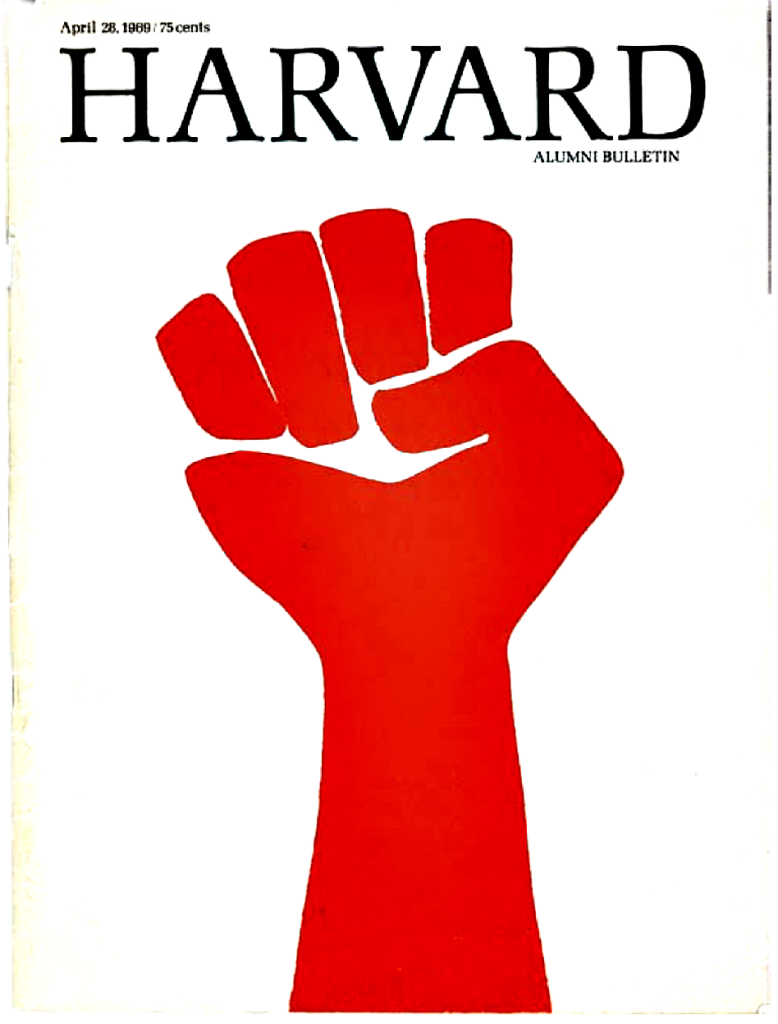
This cover from the April 1969 issue of the Harvard Alumni Bulletin says all you need to know about the times. It seems what’s old is new again.
This fall Harvard has been in the news for all the wrong reasons. From the doxxing of students in the Square, to protests and takeovers, to shouted accusations of genocide, to botched Congressional testimony, even pending Federal intervention, it has been one bad news-item after another. And while I can’t say for certain, as my lived experience doesn’t stretch back that far, I don’t think there has been a more unsettled period at Harvard since the Vietnam protests in the late 1960s. The whole place crackles with tension.
The one thing that has remained an incredible constant has been life at Adams. Its spirit of tolerance, inclusion, and equity for all willing to eschew rhetoric for reason was honed through decades-long civil debate over wars, apartheid, women’s rights, gay rights, and the rights of the right. Through it all, our House, and it is OUR house, has provided a safe haven for people of divergent beliefs willing to express themselves peacefully and listen thoughtfully to opposing sets of views.
This refuge—often in highly charged campus environments—has been made possible by a succession of strong and consistent leadership actions by our housemasters—the Kielys, the Palfreys, and now Mercedes Becerra and Salmaan Keshavjee—who have governed (and often defended) our voluble and outspoken community with far-sighted wisdom, and most importantly, with an incredible sense of empathy, allowing our young people a safe space to grow, learn, and sometimes, make stupid mistakes. We were all young and foolish and 20 years old once, and I doubt there is a person among us who isn’t grateful to have had the opportunity to err within our protective cocoon, and later, through growing maturity and gained perspective, to correct the course. We learn(ed) as much through our shared experience within the house as we do (did) in the classroom.

One of the panels from the newly restored Coolidge Room. The verse on the left is from Horace’s Odes, Book IV, poem 12. “It is sweet to play the fool sometimes.” The verse on the right is from Vergil’s Aeneid, Book 1: “One day we’ll look back on this and smile.”
That is, after all, the essence of Harvard undergraduate life, and why Adams and the other individual houses exist in the first place.
Yet ironically all this comes at a time of a dangerous genericization of the House experience under the guise of “equity.” No single house should have something the others don’t have, so the thinking goes. Thus, instead of celebrating the quirky irregularities of each, there has been a push to “standardize” the House experience. While this sounds reasonable in theory, the reality is that every loss of an amenity or tradition lowers the lowest common denominator of the student experience across the board, and it never rises again. Even the annual budgets for discretionary House activities are affected, declining markedly in real terms over the last decade.
I can’t speak for the other houses, but I suspect that we at Adams have more to lose than most, and as Adams alumni we have an active role to play—if we wish to apply ourselves—in maintaining the same quality of living and standards that in no small way helped to shape everyone of us.
Some of you may remember that it was precisely 15 years ago, during the financial crisis of 2008, that our previous housemasters decided to take a risky gamble and back a revolutionary idea: offer shelter to a private charitable foundation, removed from the vicissitudes of Harvard ups-and-downs, that could help guarantee the past and future of our shared Adams heritage.
“But,” as Judy famously reminded me, “the WE is you!”
Indeed.
Well, “we“: it’s now “you.” Time to step up, my friends. The hour is nigh.
There have been occasions this fall when I have not been terribly proud to be a Harvardian.
But I have NEVER been prouder to be an Adamsian.

